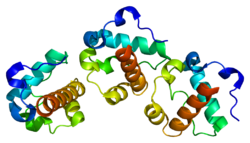Hematological malignancies
The following table lists the more frequently occurring genes to which ETV6 fuses, the function of these genes, these genes' chromosomal locations, the notation designating the most common sites of the translocations of these fused genes, and the malignancies resulting from these translocations. These translocation mutations commonly occur in pluripotent hematopoietic stem cells that differentiate into various types of mature hematological cells. Consequently, a given mutation may lead to various types of hematological malignancies. [5] [14] The table includes abbreviations for tyrosine kinase receptor (TK receptor), non-receptor tyrosine kinase (non-receptor TK), homeobox protein type of transcription factor (homeobox protein), acute lymphocytic leukemia (ALL), Philadelphia chromosome negative chronic myelogenous leukemia (Ph(-)CML), myelodysplastic syndrome (MDS), myeloproliferative neoplasm (MPN), and acute myeloid leukemia (AML). The presence of ETV6 gene mutations in myelodysplastic syndromes is associated with shortened survival. [15]
In addition to the fusion gene-producing translocations given in the table, ETV6 has been reported to fuse with other genes in very rare cases (i.e. 1-10 published reports). These translocations lead to one or more of the same types of hematological malignancies listed in the table. Thus, the ETV6 gene reportedly forms translocation-induced fusion genes with: [5] a) tyrosine kinase receptor gene FGFR3 ; b) non-receptor tyrosine kinase genes ABL2, NTRK3, JAK2, SYK, FRK, and LYN ; c) transcription factor genes MN1 and PER1 ; d) homeobox protein transcription factor CDX2 ; e) Protein tyrosine phosphatase receptor-type R gene PTPRR ; [16] f) transcriptional coactivator for nuclear hormone receptors gene NCOA2; f) Immunoglobulin heavy chain gene IGH; [17] g) enzyme genes TTL (adds and removes tyrosine residues on α-tubulin), [18] GOT1 (an Aspartate transaminase), and ACSL6 (a Long-chain-fatty-acid—CoA ligase); h) transporter gene ARNT (binds to ligand-bound aryl hydrocarbon receptor to aid in its movement to the nucleus where it promotes the expression of genes involved in xenobiotic metabolism); i) unknown function genes CHIC2, [19] MDS2, [20] FCHO2 [21] and BAZ2A .; [22] and j) non-annotated gene STL (which has no long open reading frame [23] ).
At least 9 frameshift mutations in the'ETV6 gene have been associated with ~12% of adult T cell Acute lymphoblastic leukemia cases. These mutations involve insertions or deletions in the gene that lead to its encoding a truncated and therefore inactive ETV6 protein. These mutations commonly occur alongside mutations in another oncogene, NOTCH1 , which is associated with T cell acute lymphoblastic lymphoma quite independently of ETV6. It is suggested that suppressor mutations in the ETV6 gene may be a contributing factor in the development ant/or progression of this leukemia type. [8] [24] [25]
Treatment
Patients developing hematological malignancies secondary to the ETV6 gene fusion to receptor tyrosine kinases and non-receptor tyrosine kinases may be sensitive to therapy with tyrosine kinase inhibitors. [26] For example, patients with clonal eosinophilias due to PDGFRA or PDGFRB fusion genes experience long-term, complete remission when treated with are highly sensitive tyrosine kinase inhibitor, gleevec. [14] Larotrectinib, entrectinib, merestinib, and server other broadly acting tyrosine kinase inhibitors target the NTRK3 gene. Many of these drugs are in phase 1 or phase 2 clinical trials for the treatment of ETV6-NTRK3-related solid tumors and may ultimately prove useful for treating hematologic malignancies associated with this fusion gene. [27] Clinical trials have found that the first generation tyrosine kinase inhibitors sorafenib, sunitinib, midostaurin, lestaurtinib have shown some promise in treating acute myelogenous leukemia associated with the FLT3-TKI fusion gene; the second generation tyrosine kinase inhibitors quizartinib and crenolanib which are highly selective in inhibiting the FLT3 protein, have shown significant promise in treating relapsed and refractory acute myelogenous leukemia related to the FLT3-TKI fusion gene. [28] One patient with ETV6-FLT3-related myeloid/lymphoid neoplasm obtained a short term remission on sunitinib and following relapse, on sorafenib suggesting that the cited FLT3 protein tyrosine kinase inhibitors may prove useful for treating ETV6-FLT-related hematologic malignancies. [29] Two patients suffering hematologic malignancies related to PCM1-JAK2 or BCR-JAK2 fusion genes experienced complete and cytogenetic remissions in response to the tyrosine kinase inhibitor ruxolitinib; while both remissions were short-term (12 months), these results suggest that tyrosine kinase inhibitors that target JAK2 may be of some use for treating hematologic malignancies associated with ETV6-JAK2 fusion stems. [14] An inhibitor of SYK tyrosine kinase, TAK-659 is currently undergoing Phase I clinical trials for advanced lymphoma malignancies and may prove to be useful in treating this disease when associated with the ETV6-SYK fusion gene. [30] It is possible that hematological malignancies associated with ETV6 gene fusions to either the SYK or FRK tyrosine kinase genes may someday be shown susceptible to tyrosine kinase inhibitor therapy. However, children with ETV6-RUNX1-associated acute lymphoblastic leukemia are in an especially good-risk subgroup and therefore have been almost uniformly treated with standard-risk chemotherapy protocols. [31]
Hematological malignancies associated with ETY6 gene fusions to other transcription factor genes appear to reflect a loss or gain in function of ETV6 and/or the other genes in regulating expression of their target genes; this results in the formation or lack of formation of products which influence cell growth, proliferation, and/or survival. In vitro studies of ETV6-RUNX, ETV6-MN1, ETV6-PER1, and ETV6-MECOM fusion genes support this notion. Thus, the ETV6-MECOM fusion gene is overexpressed because it is driven by the promoter derived from ETV6 [5] whereas the ETV6-RUNX, ETV6-MN1, and ETV6-PER1 fusion genes produce chimeric proteins which lack ETV6 protein's gene-suppressing activity. [32] The chimeric protein products of ETV6 gene fusions with ARNT, TTL, BA22A, FCHO2, MDS2, and CHIC2 likewise lack ETV6 protein's transcription factor activity. [32] Gene fusions between ETV6 and the homeobox gens (i.e. CDX2, PAX5, and MNX1) produce chimeric proteins with lack either ETV6s and/or CDX2s, PAX5s or MNX1s transcription factor activity. [5] In all events, hematological malignancies associated with these fusion genes have been treated with standard chemotherapy protocols selected on the basis of the malignancies phenotype.








